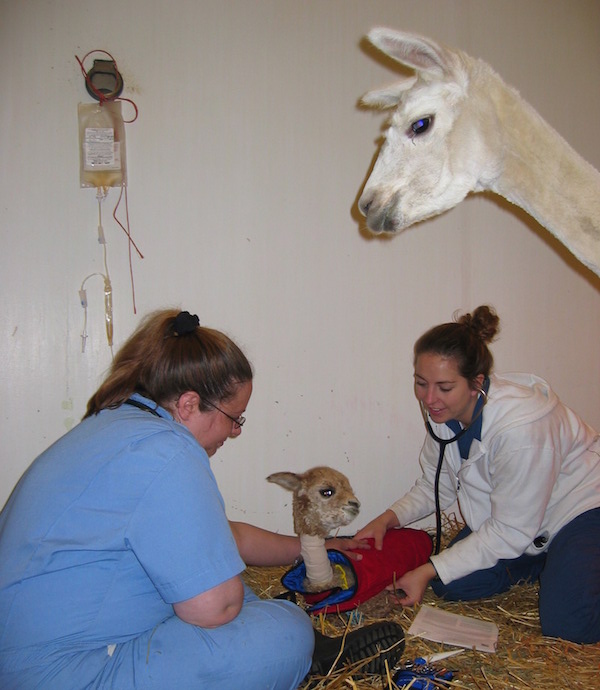Plasma is used to treat crias that have failed to suckle sufficient colostrum from their mothers during the first 24 hours of life. This means that they may be deficient in antibodies that they need to protect them from bugs they will face in the first few days and weeks of life. You can check whether or not a cria has acquired sufficient colostrum by checking their IgG concentration.
There is currently no commercial source of plasma in the UK. In the UK, your vet can collect blood from donor alpacas in your herd and process into plasma for you to store for an anticipated clinical need. If you are an owner with only small numbers of animals (and potentially no donor animals) you are allowed to use plasma from the herd from which your cria’s dam came if it was purchased within the preceding 3 years. Ideally plasma collection should be organised prior to the start of the birthing season and some preparation is required.
How do you “make plasma”?
- Donor alpacas or llamas should be chosen: ideally these should be males over 3 years old. Castrated males make perfect donors. Non-breeding females are also ideal. Donors are preferably vaccinated every 3-4 months (if they are regular donors) or 3 weeks prior to collection in order to ensure good antibody levels.
- It is very important that donor animals are calm for the collection: the process takes an average of 3.5 to 4 minutes, during which time a large needle is sited in the jugular vein and the donor needs to remain still. Therefore donors must be carefully selected to ensure the likelihood of success! Partially filled bags are unusable due to excess anticoagulant that may be harmful to a recipient cria.
- Blood is collected into 450ml bags and a special (large) centrifuge is required to centrifuge the blood (in the bags) and separate off the plasma into sterile packs that are stored in the freezer until use. Very few vets have their own centrifuges as they are quite large and can be expensive – they are not the regular centrifuges that they will use on a day-to-day basis. Blood can be sent by courier to the Pet Blood Bank at Loughborough: it will be processed there and sent back by overnight courier. Alternatively Camelid Veterinary Services is able to provide a collection and processing service for those for whom Loughborough is too far with respect to courier fees. Blood needs to be processed as soon as possible after collection. Pre-booking with either the Pet Blood Bank or ourselves is required!
[Note that it is essential that blood and plasma products are collected, stored and administered in a sterile manner. If this is not done correctly, administration of these products could be potentially very detrimental to the recipient. Examples include aspiration of collected blood into small blood tubes for spinning, followed by separation of plasma into other containers such as bags; and storage of plasma in syringes which is completely inappropriate as it cannot remain sterile. Cutting corners is not helpful to your valuable crias. The correct collection bags can be obtained from the Pet Blood Bank or from us and include all the necessary transfer packs attached to the collection bag as well as clamps to maintain bag sterility in transit.]
Storage of Plasma
Plasma is best stored in a non-domestic freezer – that is one that doesn’t have an automatic defrosting cycle – so that the plasma is maintained at a consistent temperature. Plasma that is processed by the Pet Blood Bank following good collection technique and then stored in a non-domestic freezer is fine for up to 5 years: otherwise, it should be used within a year of collection: after this it starts to deteriorate. Plasma is best used within a year of collection: after this it starts to deteriorate.
How Should Plasma Be Given To A Cria?
Plasma must always be administered by a vet. The safest and most effective means for administration of plasma to crias is by intravenous infusion via an IV catheter. Others have advocated administration of plasma by intraperitoneal (IP) infusion. However, this is about 1/3 less effective and leads to many more potential complications observed by this author following referral for these complications, particularly if either the site of injection or the plasma is not 100% sterile. Additionally, if the cria is already starting to develop sepsis, an adverse reaction to IP plasma is more likely.
Using plasma in crias: what other care is required?
Plasma alone is unlikely to be a magic cure for failure of passive transfer because many affected crias will have already started to succumb to secondary problems such as sepsis. Therefore, most crias will also need to receive antibiotics, anti-inflammatories, and ongoing fluid therapy as well as nursing support. What is needed will depend very much on the individual case, and the vet who is helping your cria will be the best person to decide what is needed. It is often necessary to perform blood tests to find out how your cria is being affected as that will determine the most suitable treatments. It may be possible to manage your sick cria at home but if you would like your cria referred to us, please ask your vet to speak to us.
If you or your vet have any questions about plasma supply or administration, or would like to consult on any sick crias, I would be delighted to hear from you and I am available for consultation on all veterinary issues relating to camelids.

